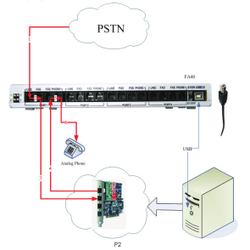FA40 User Manual
FA40 Description
In most of the time, users need to reconnect the PSTN line to analog telephone
to get it work when the PBX Server becomes power off. It may cause only a little extra
work for people who use simple and small PBX servers. But for those who run
complex PBXs in server rooms, it becomes real problems.
How to eliminate this problem? The release of OpenVox FA40 failover box for
analog line answers it. The FA40 can automatically switch the PSTN line to analog
telephone when the power of the PBX server has been cut off and will automatically
switch back to normal when the power is on again. In this way, no more worries about
getting the PSTN line connected to the telephone when the server is down.
FA40 is controlled through an Asterisk loadable module res_failover.so. This
module keeps sending “running” signal to FA40 when Asterisk is running. Once
Asterisk is down or system power is cut off, the module will not be able to send out
the “running” signal to FA40 and thus FA40 will automatically switch to the standby
telephone.
FA40 provides a reliable and flexible solution to Asterisk PBX.
FA40 Features
- Easy installation; uses USB to connect computer or server.
- Industry standard USB type B connector.
- USB 2.0 and 1.1 compliant.
- Low power consumption, takes power from USB bus.
- Standard length type A to type B cable provided.
- Supports software watchdog.
- Supports up to 4 standby telephones.
- Supports multiple FA40 devices in one system.
- Fully supports Asterisk (Version1.2/1.4/1.6).
- Supports Elastix, Trixbox.
- Small plastic enclosure: 285mm x 110mm x 34mm
- 4 power supply indicator lights.
- 5 year warranty.
- Supports all OpenVox analog cards, Digium, Sangoma analog cards and other compatible analog cards.
FA40 Installation Guide
Hardware Connection
FA40 Connection Instruction:

Device Driver Detection
The device driver of FA40 has been integrated with many Linux distributions.
Users can run the following command to see if the FA40 has been recognized or
detected by the system. (Please connect the FA40 to the server with attached USB
cable that comes together with the product. Note: Please make sure that all the lights
are on by switching the on-of button when the FA40 is connected to the server.)
# dmesg | grep FTDI

User can also run the lsusb command to check if the FA40 device is connected.
# lsusb

FA40 Working Instruction

When dial out from internal, the PSTN signal goes reverse.
When the PBX Server stops working (poweroff), the PSTN signal goes from 1->2->3:

The Dashed shows the auto-switch line goes in FA40.
When dial out from internal, the PSTN signal goes reverse.
FA40 Software Installation
Software Download
# wget www.openvox.cn/download/drivers/failover/failover-1.0-current.tar.gz
Software Installation
Installation with asterisk 1.2.X
1) Unzip the file
# tar -xzvf failover-1.0-current.tar.gz
# cd failover
2) Copy the file to res directory under asterisk
# cp res_failover.c $asterisksource/res/
3) Copy the configuration file to /etc/asterisk directory
# cp failover.conf /etc/asterisk/
4) Compile Makefile in res directory under asterisk
# vi /usr/src/asterisk/Makefile
5) Modify Makefile
MODS=res_indications.so res_monitor.so res_adsi.so res_agi.so res_features.so
To:
MODS=res_indications.so res_monitor.so res_adsi.so res_agi.so res_features.so
res_failover.so
6) If asterisk is installed, please compile it and re-install
# cd $asterisksource
# make
# make install
7) Configure the /etc/asterisk/failover.conf file on requirements.
8) Reboot asterisk
Installation with asterisk 1.4.X
1) Unzip the file
# tar -xzvf failover-1.0-current.tar.gz
# cd failover
2) Copy the file to res directory under asterisk
# cp res_failover.c $asterisksource/res/
3) Copy the configuration file to /etc/asterisk directory
# cp failover.conf /etc/asterisk/
4) If asterisk is installed, please compile it and re-install
# cd $asterisksource
# make
# make install
5) Configure the /etc/asterisk/failover.conf file on requirements.
6) Reboot asterisk
Installation with asterisk 1.6.X
1) Unzip the file
# tar -xzvf failover-1.0-current.tar.gz
# cd failover
2) Copy the file to res directory under asterisk
# cp res_failover.c $asterisksource/res/
3) Copy the configuration file to /etc/asterisk directory
# cp failover.conf /etc/asterisk/
4) If asterisk is installed, please compile it and re-install
# cd $asterisksource
# make
# make install
5) Configure the /etc/asterisk/failover.conf file on requirements.
6) Reboot asterisk
Explanation of Configuration Files
[openvox_failover_1]
device=/dev/ttyUSB0
;kick_time_interval=4000
;event_cmd=logger
;autorun=yes
[openvox_failover_2]
device=/dev/ttyUSB1
kick_time_interval=500
event_cmd=logger
autorun=no
- [openvox_failover_1]:Name of FA40 Device, to distinguish from different devices,
must to configuration;
- device=/dev/ttyUSB0:Name of USB device that FA40 uses, a must to configuration;
- kick_time_interval: the time interval of software watch dog; the default time is 4000ms,
user can customize the time with 100ms for Minimum and 9000ms for Maximum;
- event_cmd:event command, the default is logger, it will record the FA40 status in
system log;
- autorun:this decides if FA40 will start when asterisk boots; the default is yes which
means the FA40 starts when asterisk boots; if no, the FA40 will not start when
asterisk boots and user may need manually boot the device by running failover start
command.
Steps to Use
1) Start asterisk
# asterisk –vvvgc
2) Start FA40 device
*CLI> failover start # This command can start all the FA40 devices.
or
*CLI> failover start 1 # This command can be use to start the first FA40. A
difference number means to start a specific FA40 in the
server.
3) Stop FA40 device
*CLI> failover stop # This command can stop all the FA40 devices.
or
*CLI> failover stop 1 # This command can be use to stop the first FA40. A
difference number means to stop a specific FA40 in the
server.
4) Show FA40 device information
*CLI> failover show # Show FA40 device information
5) Reload FA40 device configuration file
*CLI> failover stop # All the FA40 device must be stopped before reloading the
configuration file
*CLI> failover reload # Reload the configuration file
Software Installation by the res_failover.so
If you do not have the gcc compiler and the source code of the asterisk, you can also
download the res_failover.so and use it directly as below.
1) Download res_failover.so
Check the asterisk version
# asterisk –V
Download the suitable version from
http://www.openvox.cn/download/drivers/failover/
2) Unzip the file
# tar -xzvf res_failover-1.X.X.so-for-asterisk-1.X.X.tar.gz
# cd res_failover-1.X.X.so-for-asterisk-1.X.X
2) Copy the so module file to /usr/lib/asterisk/modules
# cp res_failover.so /usr/lib/asterisk/modules
3) Copy the configuration file to /etc/asterisk directory
# cp failover.conf /etc/asterisk/
4) Configure the /etc/asterisk/failover.conf file on requirements.
5) Reboot asterisk
Technical Support
If you meet any technical problems when using OpenVox products, you can check our
Forum for help or contact us directly be the following ways:
I. Email Support
You can email your technical problems to the following emails:
[email protected]
[email protected]
Unless it is an emergency, this is always the most efficient way to get support.
II. Phone Support
If it is an emergency, the fastest way to have your problem solved is to call our technical
department at
+86-755-82535362
+86-755-82535462
+86-755-82535095
Our work time is 9:30am to 17:30pm, from Monday to Friday, (GMT +8 Beijing Time).
Reference
www.openvox.cn
www.digium.com
www.asterisk.org
www.voip-info.org
www.asteriskguru.com
OpenVox is a trademark of OpenVox Communication Co. Ltd.
All other trademarks are of their respective owners.
